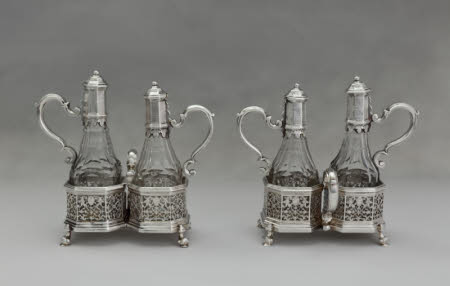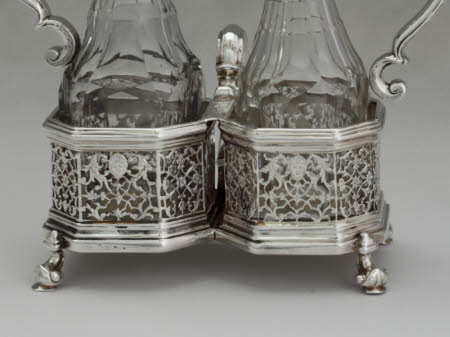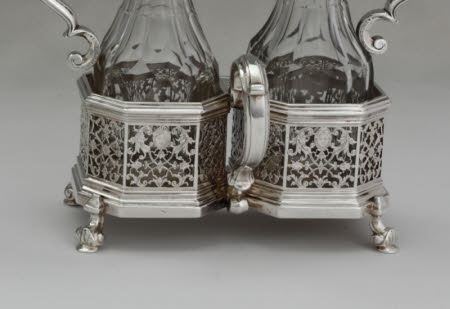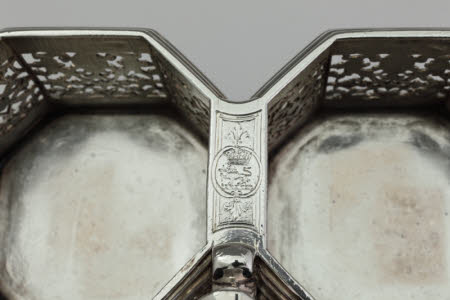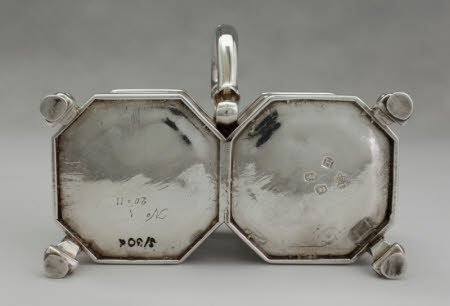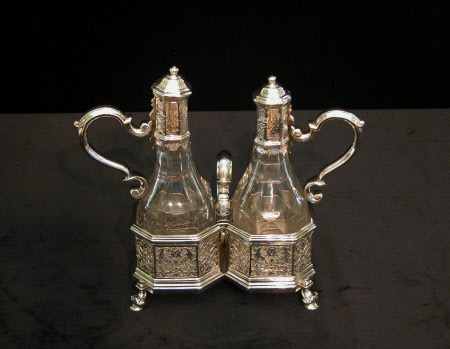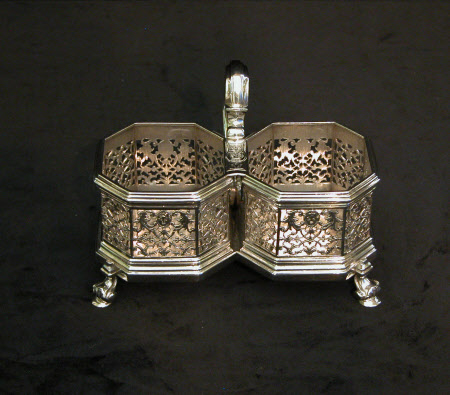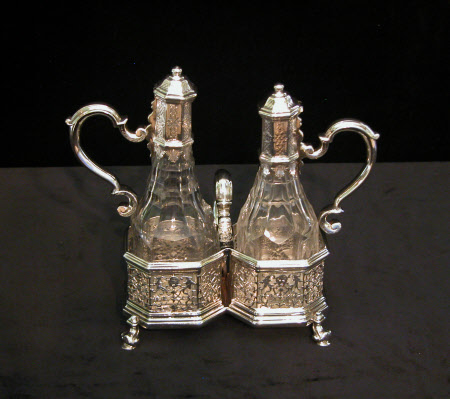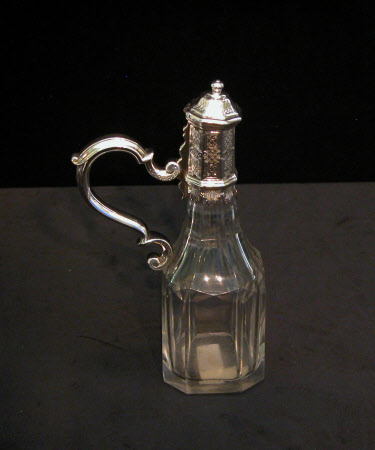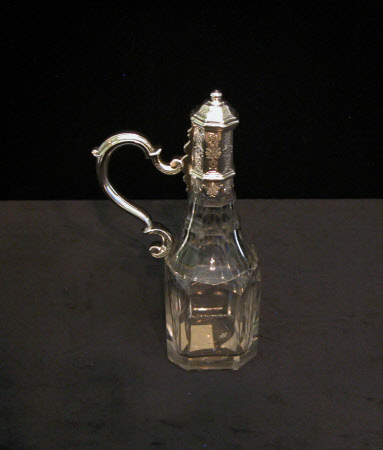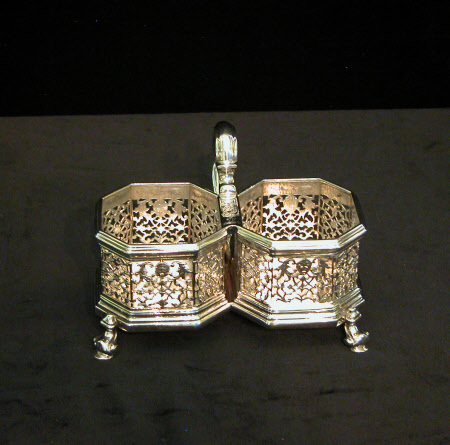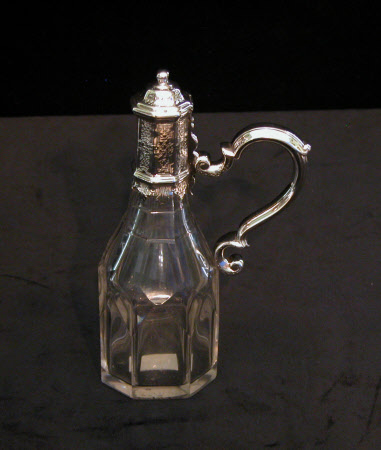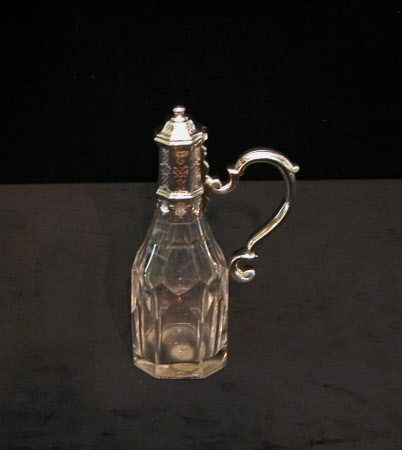Pair of cruet frames with bottles from an epergne
Paul de Lamerie (1688 - London 1751)
Category
Silver
Date
1723 - 1724
Materials
Silver, Glass
Measurements
20.6 x 15.9 x 11.1 cm
Place of origin
London
Order this imageCollection
Ickworth, Suffolk
NT 852085
Summary
Pair of cruet frames with bottles from an epergne, by Paul de Lamerie, London, 1723/4. The frames are each formed as two irregular octagons on four cast scroll and pad feet. The upper and lower mouldings are cast in two halves and the sides are pierced and engraved with foliate scrolls and female masks. The cast scroll handles, which are ribbed and capped and have trelliswork on matted grounds on the outer edges at their extremities, are soldered to the frames at the joint between the two octagons. Bridging the horizontal upper gap between the octagons is a slip of sheet silver engraved with a C-scroll cartouche between leaves and on a matted panel with incurving ends. The facet-cut colourless glass bottles conform to the frames in their lower halves, rising to true octagons. They are surmounted by silver octagonal neck mounts engraved in Régence fashion, alternately with double incurved panels of trelliswork around stylised flowers and interlocking foliate strapwork. The mounts have chased leaf skirts and hinged domed octagonal covers engraved to match. There are plain ball finials and no spouts. Applied to the rear panels of the mounts are wavy crestings to which are soldered the tops of the scroll handles, the bottoms resting against the glass bottles. The pairs of bottles are not of the same height, suggesting that one or other is a replacement. Heraldry: Within the cartouche of the bridge between the octagons of each frame the Hervey crest beneath an earl’s coronet has been engraved c.1737. Hallmarks: Fully marked on underside of both frames, maker’s mark ‘LA’ star and closed crown above fleur-de-lis below (third mark, unregistered - see Susan Hare (ed.), Paul de Lamerie, At the Sign of the Golden Ball, London, 1990, p. 29), date letter ‘H’, Britannia and lion’s head erased. Bottle mounts unmarked. Scratchweights: On undersides of frames, ‘No 1 [/] 20=11’ and ‘No 2 [/] 20=13’
Full description
For general comments on the Scarsdale epergne, of which these frames formed a part, see NT 852084 (six casters by Paul de Lamerie, 1723/4). The glass bottles were for oil and vinegar which would have been used as condiments in much the same way as they are now. Many such bottles were supplied in frames and mounts similar to these which are amongst the earliest English survivors, the only older examples so far recorded being two of 1722, one by de Lamerie and the other by Benjamin Pyne.[1] The form originated in late-seventeenth century France and can be seen on a surviving cruet of 1697 probably by Claude Charpentier and constructed of two conjoined circles.[2] Other comparable frames to those at Ickworth in public collections include that of 1727 by de Lamerie at the Ashmolean Museum, with a more open, strapwork gallery, and one of 1723 by Paul Crespin in the Museum of Fine Arts, Boston.[3] The latter, probably having always been gilded, survives in pristine condition with crisp engraving and piercing and allows a full appreciation of the superb craftsmanship which has been somewhat blurred on the Ickworth frames by their extensive wear. The piercings of the Ickworth, Williams (National Museum Cardiff) and Kirkleatham (Temple Newsam) frames are near identical, suggesting shared design sources amongst the three goldsmiths and the likely use of the same highly skilled subcontractor. The cruet frames would have been fitted beneath with square sockets enabling them to be held aloft on brackets connected to the body of the epergne. These have been removed but they survive on many other frames from the period which must originally have been part of epergnes, and they are, of course, also present on the Williams and Kirkleatham examples where they continue to perform their intended purpose.[4] James Rothwell, Decorative Arts Curator December 2020 [Adapted from James Rothwell, Silver for Entertaining: The Ickworth Collection, London 2017, cat. 12, pp. 83-4]. Notes: [1] Christie’s, 26 April 1966, lot 138. [2] Faith Dennis, Three Centuries of French Domestic Silver, New York 1960, vol. I, p. 88, fig. 90. See also the drawing of one belonging to the Duc d’Aumont c.1700, Carl Hernmarck, The Art of the European Silversmith, London 1977, vol. 2, fig. 437. [3] Timothy Schroder, British and Continental Silver in the Ashmolean Museum, Oxford 2009, cat. 134, pp. 352-4 and Christopher Hartop, The Huguenot Legacy: English Silver 1680-1760, London 1996, cat. 22, pp. 154-5. [4] For other examples of surviving sockets on frames no longer part of epergnes see Sotheby’s 20 April 1972, lot 148 (Paul de Lamerie, 1733), Christie’s 27 November 1991, lot 99 (Paul de Lamerie, 1723) and Christie’s 25 November 2008 (Peter Archambo, 1733, from Althorp).
Provenance
Nicholas Leke, 4th Earl of Scarsdale (d. 1736); 1st Earl of Bristol (bought, as part of an epergne, 1737, at the Scarsdale sale); by descent to the 4th Marquess; accepted by the Treasury in lieu of death duties in 1956 and transferred to the National Trust.
Credit line
Ickworth, the Bristol Collection (National Trust)
Makers and roles
Paul de Lamerie (1688 - London 1751) , goldsmith
